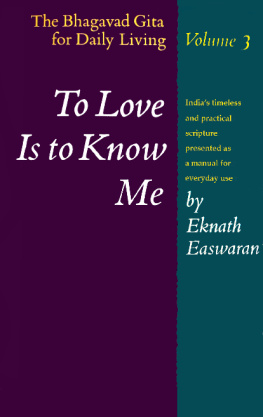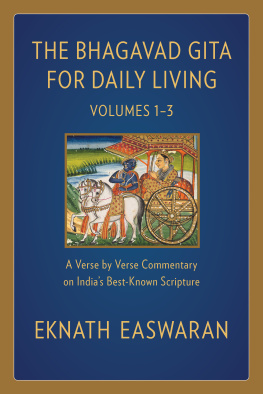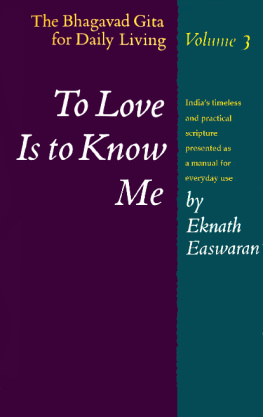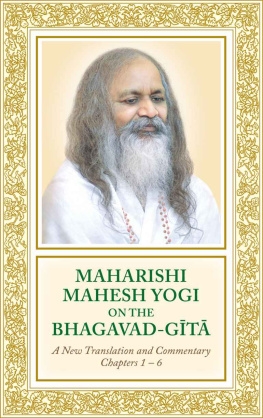INTRODUCTION
A Higher Image
One of the first lessons I learned in geography was that the earth is round. Our little village in South India had been left out of the march of modern civilization, and most of us hadnt heard this terrible news. Even my teacher was a little diffident in presenting it to us. You may not believe this, he began, and if you dont, I sympathize completely. But this is what they gave me to understand when I did my teachers training in Madras.
When I went home that afternoon, my Granny was waiting for me as always by the front gate, ready with her usual greeting: Well, Little Lamp, what did you learn in school today? Somehow this was never an automatic question; each time it was fresh and her interest genuine.
Brace yourself, Granny, I said. You may not believe this, and if you dont, I sympathize completely. But today my teacher told us that the earth is really round. Shattering the illusions of a grannys lifetime.
Not a hair fell out of place. What does it matter? she asked. You can be selfless whether the earth is round or square or triangular.
That took some wind out of my sails. But there was still my mother; she was much easier to surprise. I marched over and said, Guess what we learned today.
I cant, she said. You tell me.
The earth is round!
She fell into a paroxysm of laughter which still rings in my ears. She never let me forget that moment, and I dont think she ever believed me either. Now and then, when I would leave in the morning for school, she would send me off with Goodbye and dont slip off! Even after I became a university professor, which is a very prestigious position in India, she used to introduce me to a new friend by saying proudly, This is my son, who is Chairman of the Department of English. He writes for the Times of India and delivers talks over All India Radio. Then she would add, But he still thinks the earth is round!
I used to try to reason with her. This isnt just some theory, Mother, Id say. It has been proved over and over again. Her point was inarguable: for her, a flat earth worked. When I go to the temple, shed say, I dont roll off. When you go to school, you dont slide down the sides. It looks flat; why should I change my mind?
Once I saw the practicality of this point of view, I ceased trying to convince her. In fact, when I reached this country I was impressed to learn that there is a Flat Earth Society with many members who probably function in life quite adequately. As long as you keep within a certain sphere of activity, believing that the earth is flat is a harmless piece of ignorance which interferes very little with daily living.
Virtually all of us, however, are subject to a much more pervasive kind of ignorance which affects every detail of our lives: we believe that we are wholly physical creatures, who can be satisfied in wholly physical ways. This belief has profound practical implications. On the individual level, it means we believe that if we can give a person the capacity to satisfy physical needs and desires, he or she will be happy. Technology will be able to solve our health problems and provide material comfort for everyone. It will also be able to solve our mental problems, since personality and behavior are determined by our chemistry. Progress is measured in terms of material growth, value in terms of material assets. Even a persons work is evaluated as a commodity. Finally, there is nothing like a moral order, only the principles of natural selection; so our only rational guide for action is self-interest.
The great religions of the world have always taught that there is more to the human being than the body: an essential core of personality that is not physical but spirit, divine. Yet at the very deepest levels of thinking, almost all of us identify with the physical body: When my body dies, we say, I die. All our responses to life are conditioned by this belief. In a sense, of course, this is simply the human condition. But today, I think, the physical approach to life has become a kind of epidemic in modern industrial civilization, East as well as West. Never in history, to my knowledge, has a civilization reflected a lower image of the human being: a physical, chemical organism with no motivation higher than self-interest, no aspirations that cannot be fulfilled on the physical level.
Sometimes I hear the same argument that my mother used to give to support her belief that the earth is flat: Well, whatever you may say, this physical image of man works . Its true that I think of myself as just a physical creature, but Ive done all right. I havent fulfilled all my desires, but Ive gained some of what I wanted out of life. With just a little more, Id call myself happy. And in terms of human progress, it seems to me that the more weve concentrated on the physical level of life, the better things have been for everyone: more prosperity, more comforts, more leisure time, better health, more variety of things to do and have and enjoy.
I never try to argue with this at all. In small situations where there is no great challenge, you can squeak by in life with such a limited self-image, just as you can get to the store and back without believing that the earth is round. Unfortunately, however, small situations are becoming fewer and fewer: in todays troubled world, it is a major challenge simply to raise a family or to keep personal relationships intact. Individually and globally, I would say, this business of looking on the human being as no more than physical is leading us into disaster.
Let me give two or three examples; there are many more in the chapters which follow.
For one, I have just finished reading a well-written article in a popular magazine on brain research. Neuroscientists now have the technology to study brain activity at the molecular level, and they feel they are on the threshold of the human personality, the last frontier. Can you believe, the writer asks, that the seat of the human personality is a three-pound glob of matter with the consistency of Jello? I replied frankly, No, I cant. To me, looking for personality in the brain is like taking apart a light bulb to learn about electricity. The brain is a physical organ; personality is a force or, more precisely, a complex of forces, as the Gita will explain in the next chapter. The brain is necessary for the expression of these forces in a human being, and this has certain chemical consequences. But to confuse the consequences with the cause is not only superficial, it leads to dangerous conclusions as well.
I was quite interested in the details of this research. The brain, researchers now estimate, consists of perhaps a hundred billion neurons, each as complex as a little computer. During recent decades, with dedicated study and the help of sophisticated technology, they have isolated and identified more than a dozen neurotransmitters chemicals produced in the brain which transmit electric signals, and therefore information, from neuron to neuron. Recently they have learned to map the myriad folds of this three-pound glob without invasive surgery. On this map researchers hope to locate the seat of various human characteristics, so they can locate, for example, the area of the brain that lights up when we feel jealous. If they can then synthesize a chemical block for the neurotransmitter involved, they say, and get it to the proper site in the brain, no one need be plagued by jealousy again.















